As the year turns, the wild energy of the summer solstice starts to fade, making way for the first fruits of the harvest season.
Lughnasadh is a pagan harvest festival celebrated at this time that has its roots in Celtic mythology.
If you have ever wondered about the blessings of Lughnasadh and how to celebrate this ancient festival, this article is exactly what you have been looking for!
This article may contain affiliate links. If you click on one of them, we might receive a small commission (at no extra cost to you). Thanks for your support to help us keep this site running!
Table of Contents
What is Lughnasadh?

Lughnasadh, also referred to as Lammas, is a Gaelic festival that celebrates the start of the harvest season and the ripening of the first fruits.
The Lughnasadh festival, which is named after the Celtic God Lugh, is full of rituals and customs.
These have been passed down from generation to generation.
Lughnasadh was first held to honor Tailtiu, who was Lugh’s foster mother.
Irish legend says that the mother Tailtiu died of exhaustion after making the plains of Ireland ready for farming.
The games held in her honor are known by various names, including the Tailteann Games, and the Óenach Tailten.
They were similar to the ancient Olympic Games.
These games were a wild mashup of music, stories, trading, matchmaking, and different kinds of sports, such as horse racing and martial arts.
Another one of many interesting Lughnasadh customs was that young couples joined hands through a hole in a wooden door and entered into a trial marriage for a year and a day.
Note: Please don’t get confused by the spelling of Lughnasadh. In modern Irish it is usually written as Lúnasa.
When is Lughnasadh?
Lughnasadh was traditionally celebrated on August 1.
This is not just a coincidence. It is a sign that the harvest season is really getting going.
At this time the first grains are ready to be gathered and the first fruits start to ripen and fall.
Some modern celebrations are held on either the last Sunday of July or the first Sunday of August.
(This is because the Irish weather is hard to predict and the harvest season is a busy time to work.)
Reek Sunday is the last Sunday in July. Every year, on Reek Sunday, people make a pilgrimage to the top of Croagh Patrick.

This Christianized version of the ancient Lughnasadh tradition is a great example of how the festival has changed over time to fit the changing religious landscape.
Lughnasadh is a cross-quarter festival, like the other festivals in the old Gaelic year that marked the changes between the seasons.
Most of the time, they start the night before the main festival and end when the sun goes down on the day of the festival.
These are the festivals:
- The spring festival Imbolc (February 1)
- The summer festival Beltane (May 1)
- The summer harvest festival Lughnasadh (August 1)
- The end of the harvest festival of Samhain (November 1)
What are Lughnasadh Blessings?
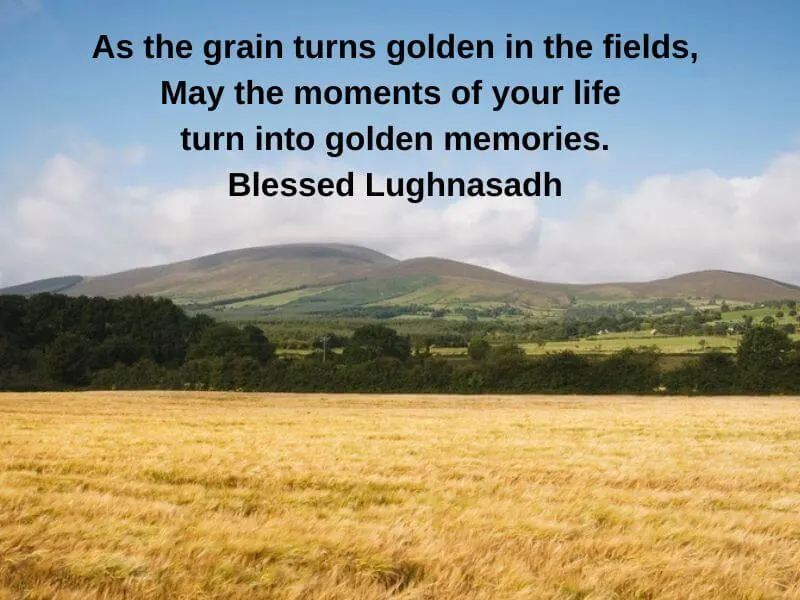
Blessings for Lughnasadh, which are associated with the festival, are expressions of gratitude, hope and plenty.
They celebrate how much food they got from the harvest and ask for protection and blessings of good luck for the fall season.
Because the festival is all about the harvest, Lughnasadh blessings, sometimes also called Lammas Blessings, often have to do with grain, fruit, and the earth’s bounty.
Lughnasadh Blessings
Although blessings have a long and rich history in Irish culture, Lughnasadh blessings are a more recent creation.
These Lughnasadh blessings do not come from ancient texts. Instead, they are mostly a modern take based on the original rituals and meanings.
May your harvest be plentiful,
Your barns full, and your heart joyful.
May the season of Lughnasadh
Bring you blessings of abundance and prosperity.
May the blessings of the harvest be upon you,
May the god Lugh’s light guide your way,
May your heart be as full as the summer’s bounty,
And may the promise of the season be with you every day.
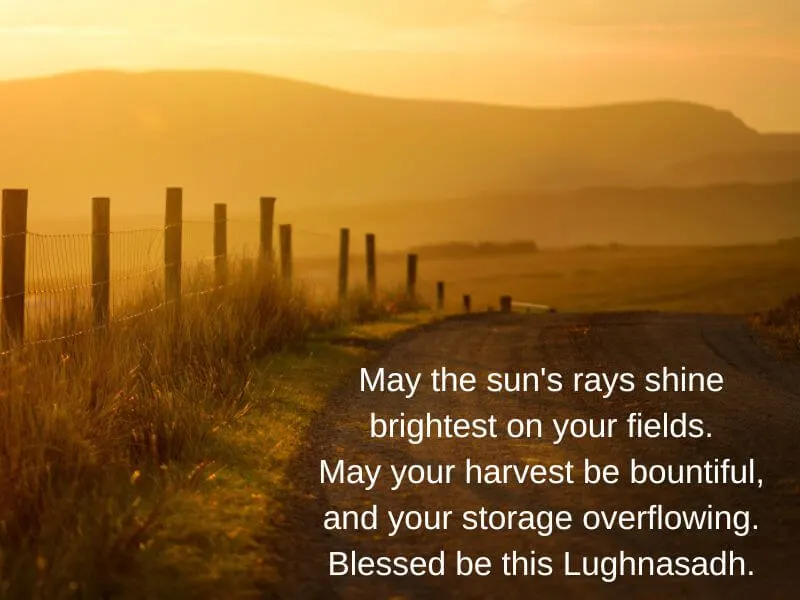
May the sun’s rays shine brightest on your fields.
May your harvest be bountiful, and your storage overflowing.
Blessed be this Lughnasadh.
Blessings of the ripe grain to you,
Blessings of the abundant field.
May you find abundance in life
As the Earth shows her abundance to us.
May Lugh, the skilled god, bless you with talents aplenty.
May you reap the fruits of your efforts
And celebrate the work of your hands.
As the grain turns golden in the fields,
May the moments of your life turn into golden memories.
Blessed Lughnasadh
May the blessings of the Harvest’s bounty be with you.
May your hard work yield joy, success, and fulfillment.
Happy Lughnasadh.
May the fires of Lughnasadh burn bright,
Bringing light and warmth to your heart.
May your harvest be plentiful and your heart be full.

Blessings upon you and your hearth on this Lughnasadh Day.
May the energy of the Earth and the bounty of the Harvest
Strengthen and nourish you in the year to come.
In honor of Lugh,
The master of arts,
May your creativity
Flow like the ripe grains
Falling from the stalk.
Blessings on this Lughnasadh day.
Just as the loaf baked from the first harvest grain nourishes us,
May the blessings of this season nourish your soul.
Blessed Lughnasadh.
As the Earth provides its bounty for us,
May you find abundance in all aspects of your life.
Happy Lughnasadh, and blessings for a fruitful harvest.
Lugh, Guardian of the wild and cultivated crops,
With every lightning strike of Summer
You go into the Grain infusing it with Your potency.
You help us on our journey
And You aid us with clear communication
That we may be successful in life.
We honor Your life and Your sacrifice,
For with every death there is new life.
This last blessing is by Arianna Alexsandra Collins from Hearken to Avalon.
Related Article: Blessings for Samhain, the Celtic New Year
How to Celebrate Lughnasadh?
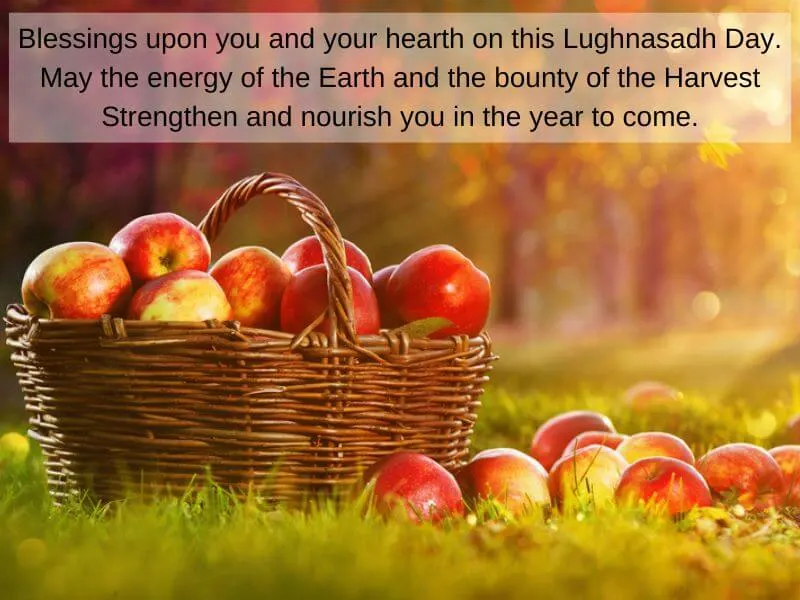
The rich tapestry of Lughnasadh traditions connected with this festival can be seen in the many different ways that Lughnasadh is celebrated.
On Reek Sunday, people often climb some of Ireland’s most famous hills and mountains, like Croagh Patrick.
Some climb as part of a Christian pilgrimage, while others do it for fun.
Other traditions for Lughnasadh include going to holy wells, or clootie wells as they are known in Scotland.
At these wells, sometimes coins are left as gifts or rags are tied to the branches of nearby trees. (These trees are typically hawthorn. This tree species has a rich cultural history all of its own!)
The act of visiting wells and leaving tokens behind is an exceptionally old tradition, thought to bring healing.
Another tradition is to make bread from the first grain of the season, which has been done for a long time.
Lammas gets its name from the tradition of baking bread, which is a link to our ancestors who lived off of the grain harvest.
Lughnasadh is also a time when people traditionally get together to play games, dance, rejoice and have fun.
At these events, people often compete in sports like weight-throwing, hurling, and horse racing.
Folklore says that everyone who climbed the hill wore colorful flowers and buried them at the top as a sign that summer was coming to an end.
Wiccans and other neo-pagans have embraced Lughnasadh and added it to their yearly cycle of Sabbats in the modern era.
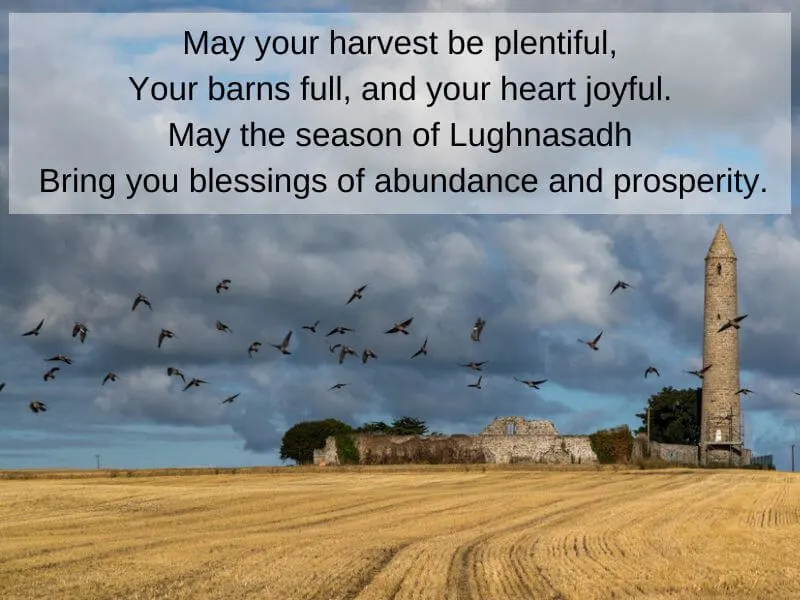
During these rituals, the goddess of grain is honored, the sun’s power is acknowledged, and thanks are given for the harvest’s bounty.
Lughnasadh Festival FAQ
Is Lughnasadh a Pagan holiday?
Yes, Lughnasadh is a part of pagan history because it started as a Gaelic festival. Today, many groups, such as neo-pagans and Wiccans, celebrate it.
When is Lughnasadh celebrated in the Northern Hemisphere?
In the Northern Hemisphere, Lughnasadh is traditionally celebrated on July 31 – August 1.
This is traditionally midway between the summer solstice and autumn equinox (or the closest full moon at this point).
But the celebration can be moved to the next Sunday, either the last Sunday in July or the first Sunday in August.
What is the significance of bread during Lughnasadh?
During Lughnasadh, bread is very important because it is made from the first grain of the harvest season.
This tradition is a direct link to our ancestors, who lived off of the grain harvest.
How is Lughnasadh celebrated in modern times?
During modern Lughnasadh celebrations, people often bake bread, climb hills, and get together for parties with music, dancing, and games.
Neopagan and Wiccan groups often hold rituals to honor the goddess of grain and give thanks for the harvest’s bounty.
Who is the god of the Lughnasadh holiday?
Lughnasadh gets its name from the Celtic god Lugh, who is a sun and harvest god.
The festival was first held to honor Tailtiu, who was Lugh’s foster mother.
What is the Lughnasadh meaning?
The meaning of Lughnasadh is that it is a pagan holiday (plus one of the eight Wiccan Sabbats during the year) that celebrates the beginning of the harvest season.
It is based on a very ancient tradition connected with the Celtic God Lugh that gives thanks for the start of the harvest.
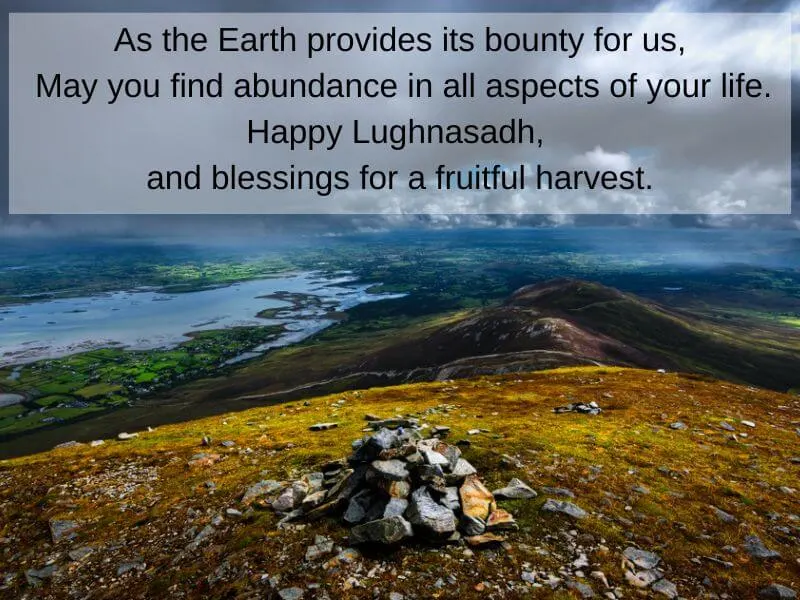
Lughnasadh Blessings and more
As we have learned about the history, traditions, and blessings of Lughnasadh, we have found that it is a festival with a lot of history and a strong connection to the rhythms of the earth.
Whether you are baking a loaf of bread, climbing a flower-covered hill, or saying a Lughnasadh blessing over the first fruits of your garden, celebrating Lughnasadh connects us to the ancient past and the cycle of the seasons.
So, on Lughnasadh, why not take a moment to appreciate the harvest and how the year keeps going around and around?
